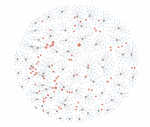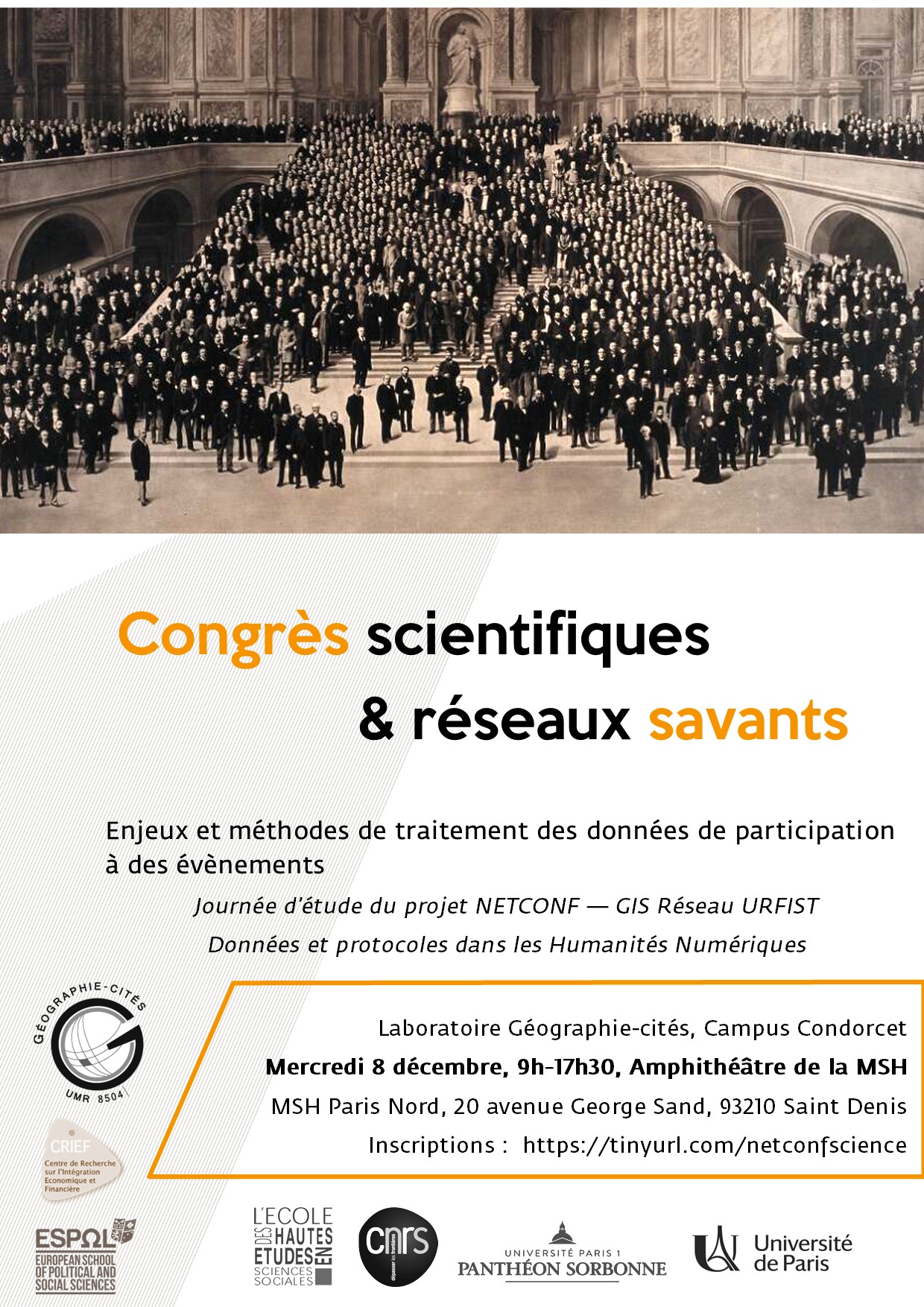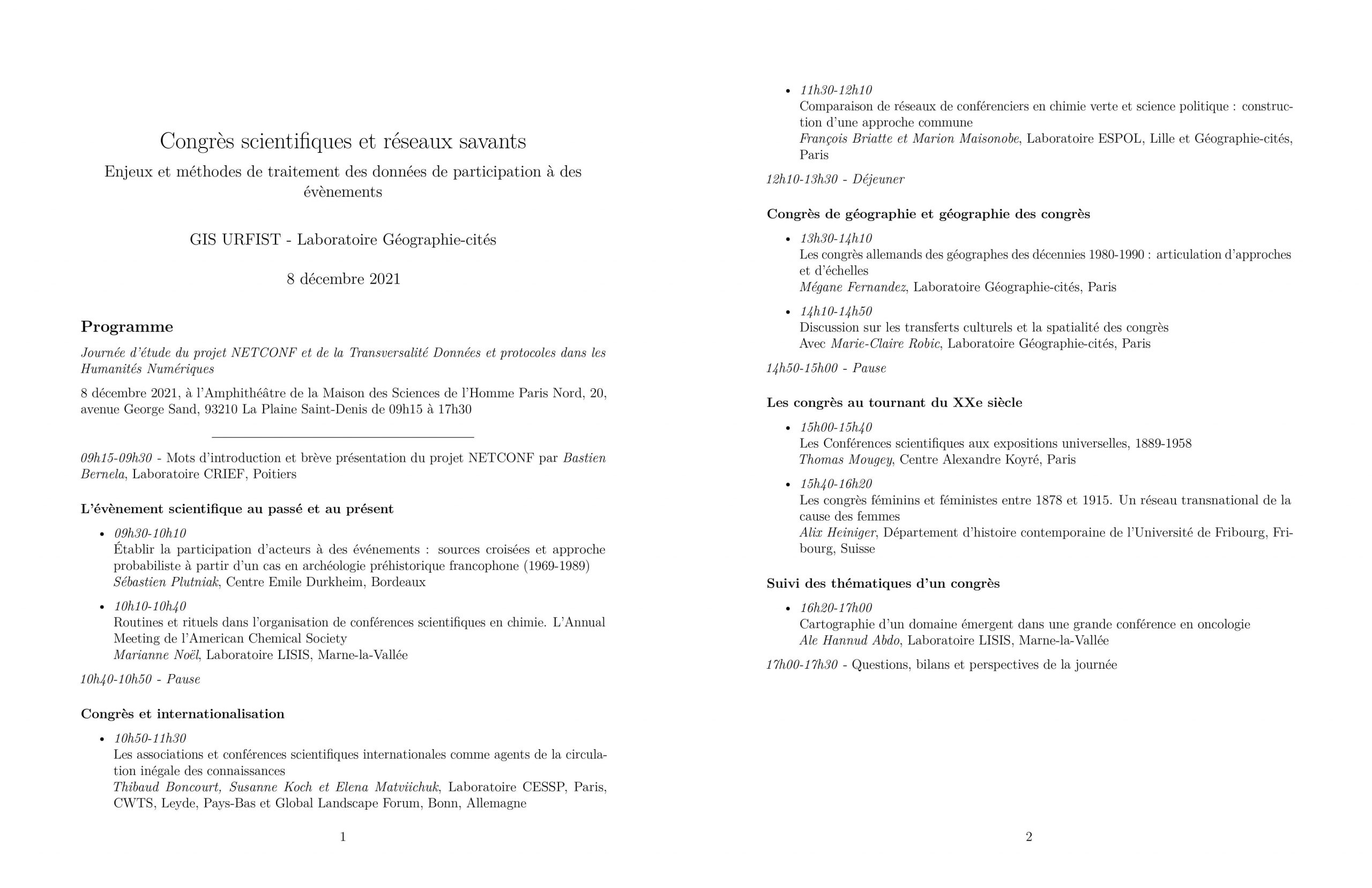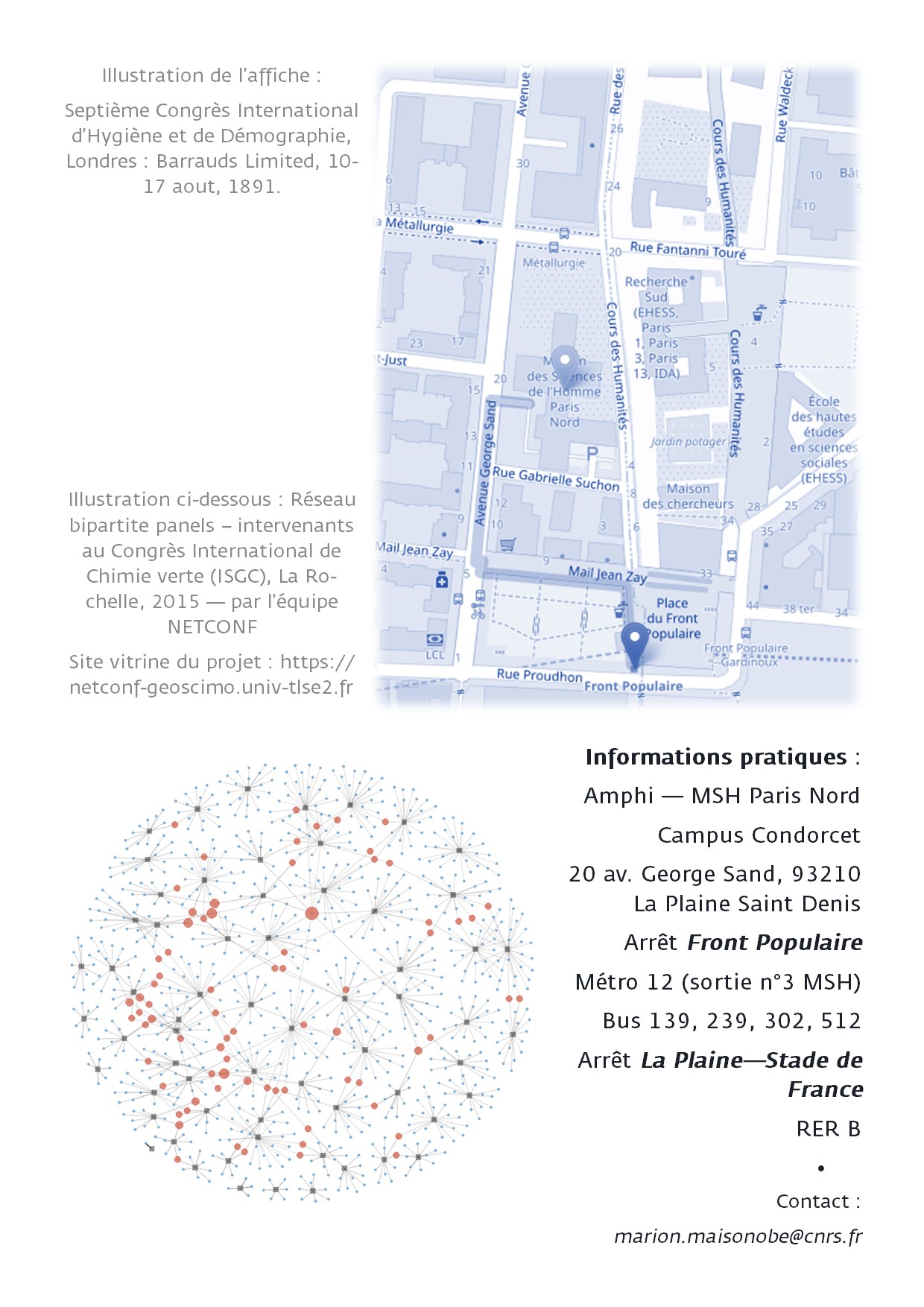The research day Scientific Conferences and Scholarly Networks organized on December 8, 2021 at the Campus Condorcet was held in the amphitheater of the Maison des Sciences de l’Homme (MSH Paris Nord). A part of the audience followed the day remotely. This event was funded by the GIS Réseau URFIST (NETCONF project) and the Transversalité Données et Protocoles dans les Humanités Numériques of the Géographie-cités research lab. Minutes of the meeting by Mégane Fernandez et al. are available online in french. An english version will soon be available. The slideshows and summaries of the presentations are available below.
This research day focussed on scientific congresses and conferences as both geographical and disciplinary spaces for the circulation of knowledge. Emphasis was placed on the methods available for studying data on events’ participation, noting that unlike the study of bibliographic corpora, which benefits from well-stabilised bibliometric methodologies, the study of scientific events is not as well established. Different approaches were addressed: ethnography, analysis of co-participation networks, content analysis. By bringing together historians working on congresses from the turn of the 20th century with social scientists working on congresses from the second half of the 20th century and today, the day brought out similarities but also differences in approaches, types of sources, questions and methodological obstacles.
Programme of the day and slideshows
Introduction and presentation of the NETCONF project by Bastien Bernela (Laboratoire CRIEF, Poitiers ) and Marion Maisonobe (Géographie-cités, Paris and Aubervilliers)
Background:
Congresses are multifaceted objects of study that are conducive to dialogue between disciplines. First of all, they can be approached as collective social events “taking place” in an ephemeral manner, in the same way as trade fairs and exhibitions, which are of interest to the sociology of events, thus justifying the implementation of ethnographic or participative approaches.
Through the documentary traces that they generate (programmes, registration registers, photographs), they provide material for presuming encounters between people. In addition to the prosopographical approach, analysing the demography, geography and content of congresses (reflected in the evolution of programmes and proceedings) is of great interest for the history of disciplines. With regard to this last aspect, it is not uncommon for scientific associations and societies to take over the congresses of their disciplines in order to follow their evolution and to trace the main lines of 20 or 50 years of existence, or even 100 years. Let us think of the congresses of the International Geographical Union, whose centenary was celebrated in a collective work in 1972 (IGU, 1972).
Through their driving role in the circulation of knowledge and the establishment of international relations, congresses are witnesses and observatories of global phenomena such as the internationalisation of scholarly communities or more cyclical ones: the repercussions of a crisis, a geopolitical conflict or a climatic hazard (Campos et al. 2018). By precipitating the organisation of online events, the pandemic that affects us also raises questions about the future of international conferences and, more broadly, about the practices of scholarly mobility and the circulation of knowledge.
Since they generally precede the publication of stabilised scientific results, conferences are potentially a step ahead of formalised science. The content and attendance of panels are therefore able to give the pulse of a speciality and anticipate current or future transformations in a field of research.
In their ritual dimension and their introduction to a community, conferences have an essential function in the process of entering an academic career. By their festive character, they have the vocation to federate and create links between members of a collective or a discipline; which is central for the sociology of social networks.
The analysis of networks as a research method lends itself readily to the study of conferences, since networks of the “actor – event” type are the subject of a separate literature in the category of multimodal networks. Strangely enough, if there was one co-attendance network based on conference data among the canonical networks that served as examples for the first applications of this methodology by Linton C. Freeman (1980), there are paradoxically few analyses of bipartite networks based on congress data in recent years.
Finally, congresses are important indicators of inequality. Because of their cost and geography, they can have an exclusionary dimension, which may be reflected in the uneven geographical origin of panellists. As they highlight some prominent members, they also tend to make others invisible, as revealed, for example, by the observation of “manels” (Else, 2019).
For all these reasons, congresses are an object conducive to dialogue between disciplines in the humanities and social sciences. The diversity of methodologies and sources currently used to study them bears witness to the variety of social phenomena they shed light on. But in the absence of dialogue, this diversity is likely to limit the comparability and transversality of the research carried out on the subject, issues which will be at the heart of the research day “Scientific congress & scholarly networks” to which we invite you.
References
Campos, R., Leon, F. & McQuillin, B., Lost in the Storm: The Academic Collaborations That Went Missing in Hurricane ISSAC, The Economic Journal, Vol. 128, no 610, 2018
Else, H., How to banish manels and manferences from scientific meetings, Nature News, 2019, Nature Group.
Freeman, L., Q-analysis and the structure of friendship networks, International Journal of Man-Machine Studies, Vol. 2, no 4, 1980
UGI, La Géographie à travers un siècle de Congrès Internationaux, UGI, 1972
Extended and open bibliography : https://www.zotero.org/groups/2408729/netconf
Past and present of the scientific event
Establishing the participation of actors in events: cross-sources and probabilistic approach based on a case in French-speaking prehistoric archaeology (1969-1989) – Sébastien Plutniak, Centre Emile Durkheim, Bordeaux
Abstract: For several decades, prosopographic methods have been used for the analysis of scientific collectives. Their use has been discussed both in general and in relation to specific disciplines, such as economics. Among the various possible sources for such analyses, conference attendance has been used, for example, conference attendance in immunology, studied from participant lists. Proposographic methods consist of studying groups from the aggregation of information about individuals. Consequently, the individuation of these people and the determination of the information relating to them are at the heart of the difficulties raised. Current work therefore takes advantage of computer tools to improve the disambiguation of personal identities and the quality of the data. This is particularly the case in classical studies, through approaches based on the use of place names and the definition of standard formats using Linked Open Data and semantic web technologies. However, in these works, the source criticism concerns the determination and standardisation of the representation of personal identities; it is, on the other hand, rare or absent with regard to the actions attributed to these persons. Thus, it is notable that, in the sociological study of immunology conferences, and despite the results obtained, the production methods and the informative quality of the available lists were not critically approached: the simple mention of a participation is enough to consider it reliable. In this work, I implement such a critique, in a perspective summarised by the expression ‘probabilistic epistemology of personal action’. If this critique is necessary to reinforce the reliability of sources, I will show that it also contributes to establishing knowledge about the scientific activities taken as object. The case of a group of researchers who practised archaeology in the second half of the twentieth century will illustrate this approach.
scientific conferences in chemistry. The Annual Meeting of the American Chemical Society – Marianne Noël, LISIS research lab, Marne-la-Vallée
Congresses and internationalisation
International scientific associations and conferences as agents of the unequal circulation of knowledge – Thibaud Boncourt, Susanne Koch and Elena Matviichuk, Laboratoire CESSP, Paris, CWTS, Leiden, The Netherlands and Global Landscape Forum, Bonn, Germany
Abstract: This talk proposes a synthesis of the existing literature on international associations and conferences in the social and natural sciences. We analyse these spaces of knowledge circulation as being both shaped by inequalities between researchers (notably geographical and gender-based) and playing a role in the reproduction of these inequalities. First, we review the scientific, social, economic and political conditions that shape the genesis and development of these spaces. Secondly, we describe the unequal representation of researchers within them. We argue that the unequal inclusion of researchers in these international spaces has social and intellectual effects.
Comparison of conference networks in green chemistry and political science: building a common approach – François Briatte and Marion Maisonobe, ESPOL, Lille and Géographie-cités research lab, Paris and Aubervilliers
Geography Congresses and Geography of congresses
German Geographers’ Conferences of the 1980s and 1990s: Articulation of Approaches and Scales – Mégane Fernandez, Géographie-cités research lab, Paris and Aubervilliers
Click here to access the bibliographic record of this presentation on the French national archive HAL.
Abstract: This talk examine the distance between GDR and West German geographers and geographies in the 1980s and how this distance affected the reunification of the scientific communities in the 1990s – in particular, it was used to justify the GDR’s reforms of higher education and research, which were unfavourable to its scientists. To answer these questions, different methods, centred on space but partly borrowed from other disciplines – social network analysis for the use of bipartite graphs; history and sociology for the longitudinal approach and the work of archives – will be exposed, crossed with statistical and cartographic analysis. All of these treatments are applied to data notably drawn from the archives of the Leibniz Institut für Länderkunde of Leipzig concerning the congresses of geographers. The congresses thus serve here as a proxy for the study of the geography of scientific communities and the interaction between science and politics
Discussion on cultural transfers and the spatiality of congresses – With Marie-Claire Robic, Géographie-cités research lab, Paris and Aubervilliers
Congresses at the turn of the 20th century
Scientific Conferences at World Fairs, 1889-1958 – Thomas Mougey, Centre Alexandre Koyré, Paris and Aubervilliers
Abstract: At the turn of the 20th century, world exhibitions became a major venue for international congresses. Between 1873, when the first series of congresses was organised at the Vienna exhibition, and 1914, hundreds of sessions and hundreds of thousands of congress participants were regularly gathered at each new exhibition. Despite the pioneering work of Anne Rasmussen, which revealed the extent of this union between two major forces in international life at the end of the 19th century, the place of universal exhibitions in the structuring of international congresses remains poorly known. Firstly, in order to highlight the specificity of the series of exhibition congresses and the different functions that were attributed to them, I will examine how exhibition administrators organised these congresses spatially and materially and thus reveal the production of competing models. I will then examine the different notions of internationalism and progress that underpinned these different models. Finally, I will conclude by attempting to place these models in a long-term perspective. I will then reflect on how these different models and the tensions that underlie them have continued to structure the practice of the congress to the present day.
Women’s and feminist congresses between 1878 and 1915. A transnational network for the cause of women – Alix Heiniger, Department of Contemporary History of the University of Fribourg, Fribourg, Switzerland
Abstract: From the last third of the 19th century onwards, social reformers and specialists on various issues met at international congresses in various cities in North America and Europe. My presentation will focus on the international women’s and feminist congresses held between 1878 and 1915, which brought together thousands of women and men engaged in the struggle for women’s rights (suffrage, civil rights, women’s work, social reform, maternity protection, etc.). As places for exchanging knowledge and national experiences, these congresses were meeting places where alliances between activists from different countries were structured, particularly through the creation of national branches of women’s and feminist organisations such as the International Council of Women. Although they have received a lot of attention in historical research, there has been no comprehensive analysis of these congresses to date, a gap that this contribution aims to fill by means of a formalised network analysis. The latter is an excellent approach to understand the whole of these congresses and to identify the connections between them and the actresses who play the role of privileged intermediaries as well as those situated at the margins of this milieu. Other transnational spaces of social reform have been the subject of quantitative analyses (Leonards and Randeraad 2019), while women’s networks have so far only been addressed qualitatively, with the exception of a pioneering article on New York State (Rosenthal et al. 1985). The works devoted to them constitute valuable monographs, most often based on a national or international organisation.This contribution is based on a corpus of 17 international women’s and feminist congresses between 1878 and 1915. They were compiled from the list published by the International Union of Associations (IUA) between 1960 and 1964 (see: Grandjean and van Leeuwen 2019). Only congresses labelled ‘women’s’ or ‘feminist’ were included. In order not to extend the corpus too much, congresses devoted to other more specific causes (suffrage, abolitionism, the ‘white slave trade’, temperance, Catholic or Jewish women, etc.) have been deliberately left out, but could be the subject of a later analysis. The Hague Congress of 1915 was added to the IUA’s series, to allow for a link to the post-war period. The participations of the people who speak at the congresses or who are responsible for their practical organisation have been listed and then formalised through a network analysis using R software and its extension Igraph.3 By examining all these participations, this contribution will show that the 17 congresses listed form a single component. By going beyond the monographic approach, it will highlight the alliances, inclusion and exclusion mechanisms within this transnational milieu of women’s reform and feminism. Within the network, it is possible to identify a group of women who play more of a bridging role (because they have higher intermediarity indices) between the congresses and help to link them together. From this point of view, and by following the biographical paths, I will show how participation in these congresses turns out to be a resource for certain actresses who are responsible for organising and structuring the efforts of their colleagues within the national framework. Finally, we will see that certain themes dealt with in these congresses are more federative in the sense that they appear more regularly. They become dominant topics of reflection around the defence of women’s rights, while those who take them up largely occupy the space and have a privileged position to disseminate their ideas. This contribution will also examine the margins, and in particular the place of women from spaces beyond Europe and North America. Network analysis is a valuable tool in this research to establish the existence of a transnational space of women’s social reform and feminism (which nevertheless privileges European and North American participation) and the power relations that are played out there.
Grandjean, Martin, et Marco H. D. van Leeuwen. 2019. « Mapping Internationalism: Congresses and Organizations in the Nineteenth and Twentieth Centuries ». In International Organizations and Global Civil Society, by Daniel Laqua, Wouter van Acker, and Christophe Verbruggen, 225‑42. Londres: Bloomsbury.
Leonards, Chris, and Nico Randeraad. 2019. « Circulations charitables: les congrès internationaux de réforme sociale (1876-1913) ». In Philanthropes en 1900. Londres, New York, Paris, Genève, by Christian Topalov, 435‑67. Paris: Creaphis.
Rosenthal, Naomi, Meryl Fingrutd, Michele Ethier, Roberta Karant, and David McDonald. 1985. « Social Movements and Network Analysis: A Case Study of Nineteenth-Century Women’s Reform in New York State ». American Journal of Sociology 90 (5): 1022‑54.
Monitoring the topics of congresses
Mapping an emerging field in a major oncology conference – Ale Hannud Abdo, LISIS research lab, Marne-la-Vallée
Click here to access the interactive slideshow of this presentation on Ale Hannud Abdo’s personal page.
Abstract: Through its application to a corpus of 80 thousand abstracts from a sequence of 23 annual conferences of the American Society for Clinical Oncology (ASCO), this work introduces a corpus mapping methodology for the identification and tracking of domains, themes, and associated dimensions. By emphasizing the connective character of documents, and starting from their narrative content, our approach allows in particular to deal with poorly or diversely structured data, as conference archives often are, and which are more adapted than academic journal corpora to answer certain questions – for example, to understand the transformations of the oncology “research front”.
Questions, assessments and perspectives of the research day
Link to the Zotero shared bibliography – discussion on how to valorise the research day.



